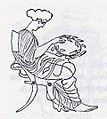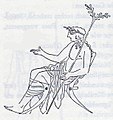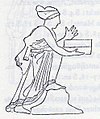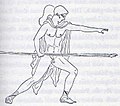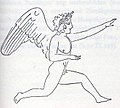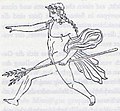Shuvalov painter
The Shuvalov painter (English Shuvalov Painter ) was a vase painter of the Attic - red-figure style. He worked between 440 and 410 BC. BC, in the high classical period (also called Parthenon period ).
The Shuvalov painter got his emergency name from John D. Beazley after an amphora that is now kept in the Hermitage in St. Petersburg . It was acquired by the collector Ivan Iwanowitsch Schuwalow in the 18th century . Most of the approximately 80 works assigned to him were found in Italy, especially in Campania and Lucania . He mainly decorated smaller vessels. The Shuvalov painter is considered to be the successor of the Mannheim painter and worked in his Athens workshop with other artists such as Aison , the Alexandre Group or the Eretria painter . His pictures show lively, small figures with intense looks. In his mythological scenes as well as in his everyday depictions, the works are considered to be among the best that was created in his time. John Boardman attests to the pictures a certain cuteness but also a tendency towards flatness.
The Shuvalov painter and his circle
The Shuvalov painter is an artist of classical Athens who is known today only through his works. Even his name has not been passed down. Due to stylistic comparisons, about 80 vases were assigned to a painter's hand. The artist of these works was given the emergency name Shuvalov painter by John D. Beazley in 1925 . The name given to the vase was an amphora , which was owned by the family of the Russian Count Ivan Ivanovich Shuvalov until 1928 . He probably acquired it in Italy in the late 18th century. Today it is in the Hermitage .
The works of the painter are dated between about 440 and 410 BC. Dated. The painter Polygnot was very influential, not only exerting a strong influence on the Shuvalov painter, but also on other artists such as the Peleus or Kleophon painter . The two painters have stylistic connections to the Shuvalov painter but do not belong in his immediate vicinity. The Mannheim painter , the Alexandre painter and the late Aison belong to the painter's workshop . They are followed by the Meidias painter and his circle. Vase painters, who generally decorated larger-format picture carriers, such as the Frauenbad painter , Polion and the Pronomos painter , as well as bowl painters such as the Kalliope painter , the Disney painter and the most important red-figure small master, the Eretria painter , also decorated small-format vessels .
It can be safely assumed that it was not the Shuvalov painter or one of the other vase painters who owned this workshop. Workshops generally belonged to the potter, the status of the vase painter is still controversial today. It is no longer possible to clarify whether the Shuvalov painter was a free citizen, meticulous or slave.
Typology
In the case of the Shuvalov painter, the use of several basic human types in the visual representation is particularly pronounced. These basic types are usually only slightly varied. The research worked out seven basic types in 23 sub-types:
- frontal stand type
- first type of side stand
- second lateral stand type
- Seat type
- Support figure
- Pursuer figure
- pursued figure
Depending on the type, the types depend on the sex, the type of standing or sitting and the direction of the figure, the posture of the extremities and the clothing.
1A: Female figure, head to the right, standing leg on the right, both feet are frontal, the right arm is usually loaded, the left arm is usually spread apart from the body.
There are six times this figure in an ungirded peplos , five times belted, three times in a chiton and coat, once as an Amazon .1C: Male figure, head to the right, standing leg to the right, both feet are shown frontally, the arms are shown variable.
The figure is shown naked on two vases, five times in a coat, once in a hiking dress , in a chitonisko , as a warrior and as Paris .1D: Male figure, head to the left, standing leg to the left and feet frontal, arms variable.
This guy is portrayed naked, in a coat, in a hiking dress and as a Persian .2C: Male figure standing to the right in profile, standing leg on the right, left foot in front, the right arm is usually higher than the left.
Three times there is the naked type, once piggybacking and leaning forward, twice in a coat or as a coat boy . A modified variant shows Heracles leaning on a club with his left foot set back.2D: Male figure standing to the left in profile, standing leg on the left, the right foot is in front, the right arm is usually higher than the left.
Twice there is this form naked, eight times in a cloak, six times as a cloak youth and once each as a warrior and in a walking dress. A modified form shows Polynices leaning on a stick with his right foot set back.5B: Type for supporting figures of both sexes. The figure is shown facing left in profile. The right leg is propped up, the right arm is near the knee.
This guy appears twice in a hiking dress and as an Amazon, once it shows a hetaera .
Reception and exploration
As early as the 19th century, some vase paintings by the Shuvalov painter were valued for their artistry. Beazley not only gave the artist his emergency name. In his book Attic Vase Painter of the Red Figure Style , published in 1925 , he performed 22 works by the painter and his school without making a distinction between the two. In 1928 and 1929 the number increased, in 1942 the number of vases assigned by Beazley increased to 55 by the painter and twelve by his school. In 1963 the list increased to 78 works by the Shuvalov painter and 15 of his school, and in 1971 to 80 and 17. His first list from 1925 was headed with the words: “Small, charming vases, including masterpieces”. The Russian archaeologist Anna A. Peredolskaja developed a particular fondness for the artist . She was the first researcher to devote her attention to him in 1927 and counted him among the “little masters”. Walter Hahland saw him less positively , who described the style of the Shuvalov painter as "brittle, angular and skinny". At least the jug with the love scene, which Ernst Buschor described in 1932 as “the master's most wonderful creation ...” was artistically outstanding. Buschor rate the vases by the Shuvalov painter in 1940 as one of the best small-format creations of his time.
Only towards the end of the 1950s did archaeological research increasingly turn to the Shuvalov painter. Thanks to new finds, which were made in the necropolis of Valle Trebba near Spina in the 1920s and 1930s , but only began to be increasingly evaluated after the war, the artist's work was better accessed. now it was possible between 460 and 420 BC. To better grasp. In the 1960s, Apolo Enrico Arias devoted himself several times to the works of the artist from Spina and in 1973 Luciano Massei presented all of the works by the painter from Spina. Since the 1970s, researchers have increasingly devoted themselves to the minor masters of the Parthenon period. The research on the Shuvalov painter culminated in the dissertation of Adrienne Lezzi-Hafter , which dealt exclusively with the Shuvalov painter and his circle in two volumes.
literature
- John D. Beazley : Attic red-figure vase-painters . 2nd ed. Oxford 1963.
- Adrienne Lezzi-Hafter : The Shuvalov Painter. A jug workshop from the Parthenon period , von Zabern, Mainz 1976 ( Research on ancient ceramics, Series II: Kerameus. Volume 2) ISBN 3-8053-0080-8
- John Boardman : Red-Figure Vases from Athens. The classical time (= cultural history of the ancient world . Vol. 48). Philipp von Zabern, Mainz 1991, ISBN 3-8053-1262-8 , especially p. 101f.
- Martin Maischberger : Wine jug of the Shuvalov painter: lovers. In: Andreas Scholl (Hrsg.): The antique collection: Altes Museum. Pergamon Museum , von Zabern, Mainz 2007, p. 76f., ISBN 978-3-8053-2449-6
Web links
Individual evidence
- ↑ Inventory number Б 4308
- ↑ Lezzy-Hafter, p. 2
- ↑ Typology follows Lezzi-Hafter, pp. 60–63
- ↑ Beazley: Greek Vases in Poland (1928), p. 65 and Notes on the Vases in Castle Ashby in Papers of the British School at Rome 11 (1929), p. 25
- ↑ Beazley: Attic Red-Figure Vase-Painters , 1942, pp. 753-757
- ↑ Beazley: Attic Red-Figure Vase-Painters , 1963²
- ↑ Beazley: Paralipomena , 1971
- ↑ Peredolskaja: Lost red-figure vases , in Römische Mitteilungen 42 (1927), pp. 230–234; at that time the Shuvalov collection was considered lost
- ↑ Walter Hahland: studies of Attic vase painting around 400 BC. Chr. , 1931 (dissertation), pp. 4-30; However, the work was a jug that is now part of the painter's school
- ↑ after Lezzy-Hafter, p. 1
- ↑ Buschor: Greek Vases , Piper, Munich 1940, p. 235
- ↑ Élanges de l'École française de Rome. Antiquité T. 85, 1973, pp. 437-481
| personal data | |
|---|---|
| SURNAME | Shuvalov painter |
| ALTERNATIVE NAMES | Shuvalov Painter |
| BRIEF DESCRIPTION | Greek vase painter |
| DATE OF BIRTH | 5th century BC Chr. |
| DATE OF DEATH | 5th century BC BC or 4th century BC Chr. |














